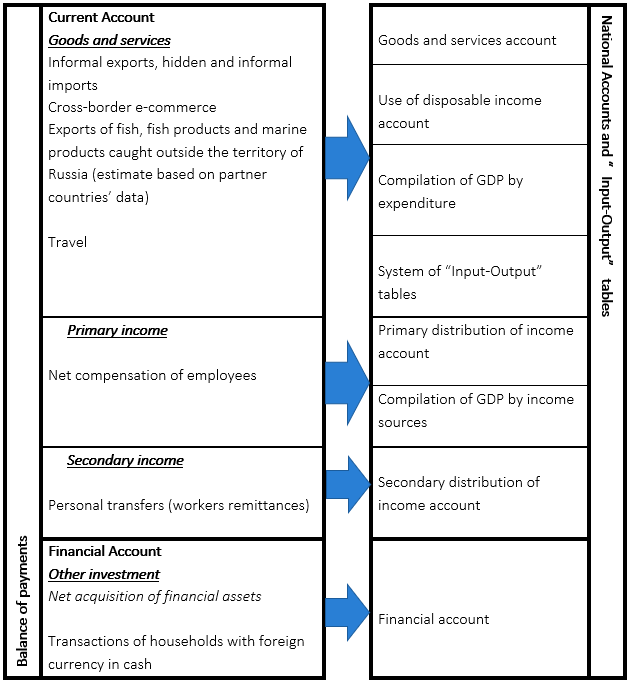 RUSSIAN FEDERATION: The Russian Practices for Encouraging Coordination between National Accounts and Balance of Payments to Produce Informal Economy Data
RUSSIAN FEDERATION: The Russian Practices for Encouraging Coordination between National Accounts and Balance of Payments to Produce Informal Economy Data
For the purposes of uniform reflection in various macroeconomic statistical systems, such as the National Accounts, “Input-Output” Tables and the Balance of Payments, of interconnected aggregates characterizing certain aspects of external economic activities, within the framework of compilation of Russian statistics there is a constant exchange of information used in compiling the balance of payments between the Bank of Russia and the Statistics Service which compiles the National Accounts and “Input-Output” Tables.
Balance of payments aggregates that include estimates of the volumes of unobserved, hidden and informal activities are used by the National Accounts’ compilers in the following directions:
Aggregates reflecting external economic transactions, that are not observed using direct statistical methods and that are estimated on the basis of application of models, are subject to both internal controls and reconciliation with other balance of payments components, and additional verification in the course of utilization thereof in compiling the SNA aggregates and “Input-Output” tables.
Thus, for example, with respect to estimating the aggregates of merchandise imports volumes that are not captured by customs statistics, the conclusion about the adequacy of figures received using the model for calculation of the mentioned components of unobserved activities is made by the balance of payments and the SNA compilers through the substitution of the respective magnitudes in the fundamental identity of the goods and services account, the essence of which means that “goods and services produced in the country must be consumed, used for saving or exported, whereas all the goods and services used in the given country must be produced in that country or imported” [1]. Otherwise, the foregoing identity may be expressed using the following formula:
C = P – I – Ex + Im ± ΔSt,
where С is consumption; P – production; I – intermediate consumption; Ex – exports; Im – imports; ΔSt – net change in merchandise stocks (in industry and trade).
The volume of goods’ resources supplied through imports that are unregistered by customs statistics, which characterize hidden and informal merchandise imports, is determined as follows (Im′):
Im′ = C – (P – I – Ex) – Im ± ΔSt
When a substantial imbalance in the aggregates of volumes of goods’ resources and their use arise, the SNA and the balance of payments compilers, through the conduct of joint consultations, make a decision either to adjust the respective aggregates of the System of National Accounts, or to undertake a correction of the method and model for estimating the aggregates of merchandise imports that are not captured by customs statistics in cases of under- or over-valuation thereof.
In addition, correction of the parameters of the model for estimating hidden and informal merchandise imports is carried out by the balance of payments compilers on the basis of the results of comparison of coefficients for recalculating the volumes of unobserved imported goods’ use from purchaser’ prices (retail prices) into imports FOB prices, with the purchasers’ prices’ structure (final consumption prices) for imported goods determined on the basis of constructed extended “input-output” tables [2]. On the basis of a correlation between prices of the buyer (end-consumption prices) and basic prices for imported goods calculated using the data from extended “input-output” tables, adjustments are introduced in the average annual coefficients for recalculating the volumes of unobserved imported goods’ use from purchasers’ prices into imports FOB prices. The magnitudes obtained for the coefficients are then used as the basic parameters in the model for estimating hidden and informal merchandise imports in the period until the next data from “input-output” tables are received.
Regarding data on exports and imports of “Travel” services compiled within the framework of balance of payments compilation, the information is used by the SNA compilers in constructing the use of disposable income account. While compiling expenditure on end-consumption of households, their expenses incurred to purchase goods and services in the territory of the Russian Federation are augmented by adding to them the value of resident households’ expenses related to imports of “Travel” services. The obtained result is diminished by the value of nonresident households’ expenses in the territory of the Russian Federation reflected in the balance of payments of the Russian Federation as “Travel” exports. In addition, “Travel” services’ exports and imports deflator indices calculated by the compilers of external sector statistics are used by the SNA compilers for recalculating the respective aggregates into comparable prices.
Ultimately, such an interaction in exchanging information and conducting comparative analysis of the data is aimed at improving the quality of both the conducted estimations and the statistics produced on the basis thereof.



